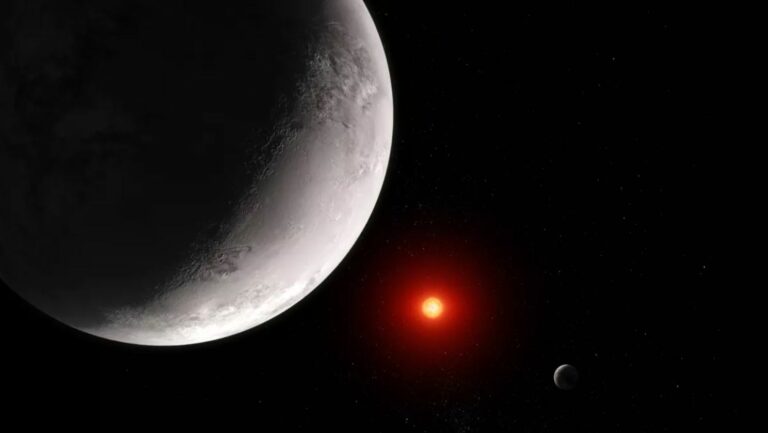James Webb Space Telescope Observes Rocky TRAPPIST-1 Exoplanet, Unveiling Discouraging Insights for Life
The latest findings from NASA’s James Webb Space Telescope (JWST) indicate that TRAPPIST-1 c, a rocky exoplanet in the TRAPPIST-1 system, possesses an incredibly thin atmosphere or possibly no atmosphere at all. The JWST data enabled astronomers to assess the heat energy emitted by TRAPPIST-1 c, unveiling that the dayside temperature of this rocky world is a record-low 225 degrees Fahrenheit (107 degrees Celsius). Consequently, the exoplanet’s atmosphere, if it exists, is likely exceedingly tenuous, according to NASA’s statement.
TRAPPIST-1 c orbits an ultracool red dwarf star approximately 40 light-years away from Earth and is part of a system containing seven rocky planets. As the most common type of star in the Milky Way galaxy, studying this exoplanet system helps astronomers gain insights into the potential habitability of worlds around such stars. Sebastian Zieba, the first author of the study announcing these results and a graduate student at the Max Planck Institute for Astronomy in Germany, expressed the researchers’ objective: understanding whether rocky planets possess atmospheres.
Zieba stated, “In the past, we could only really study planets with thick, hydrogen-rich atmospheres. With Webb, we can finally start to search for atmospheres dominated by oxygen, nitrogen, and carbon dioxide.” While the size and mass of the planets orbiting TRAPPIST-1 resemble the inner rocky planets in our solar system, the composition of their atmospheres remains uncertain. This is where the JWST’s Mid-Infrared Instrument (MIRI) proves invaluable, assisting astronomers in characterizing rocky exoplanets like TRAPPIST-1 c.
Initially, scientists speculated that TRAPPIST-1 c might possess a dense carbon dioxide atmosphere similar to Venus, given its comparable size and radiation received from its host star. However, red dwarf stars like TRAPPIST-1 emit intense X-ray and ultraviolet radiation, which can strip away an exoplanet’s atmosphere. It is also plausible that during TRAPPIST-1 c’s formation, insufficient water, carbon dioxide, and other volatiles were available to generate an atmosphere.
Using MIRI, the research team analyzed the brightness of light emitted by TRAPPIST-1 c as it passed behind its host star, comparing it to the light emitted when the planet was beside the star. This allowed them to determine the amount of mid-infrared light emitted by the planet, directly linked to its temperature and, consequently, its atmospheric composition. The observed emissions from TRAPPIST-1 c indicate a lack of carbon dioxide gas that would typically absorb the emitted light.
“Our results are consistent with the planet being a bare rock with no atmosphere, or the planet having a really thin CO2 atmosphere (thinner than on Earth or even Mars) with no clouds,” explained Zieba. Given TRAPPIST-1 c’s absence of a substantial atmosphere, astronomers propose that it may have formed with limited water or lacked other vital components necessary for a habitable environment.
Laura Kreidberg, a co-author of the study from the Max Planck Institute for Astronomy, expressed the significance of these measurements, stating, “It is extraordinary that we can measure this. There have been questions for decades now about whether rocky planets can keep atmospheres. Webb’s ability really brings us into a regime where we can start to compare exoplanet systems to our solar system in a way that we never have before.”
The new findings were published June 19 in the journal Nature.
Do not forget to share your opinion with us to provide you with the best posts !




0 Comments